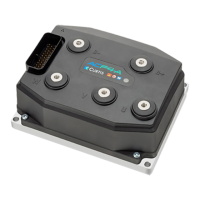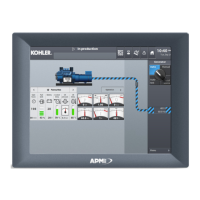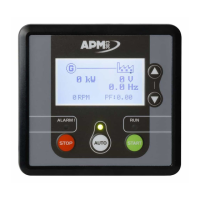7 — DIAGNOSTICS AND TROUBLESHOOTING
Curtis AC F2-A, F4-A, F6-A Motor Controllers – FOS 4.5 – April 2022 Return to TOC
pg. 236
FLASH
CODE
FAULT NAME
(Curtis Integrated Toolkit™)
POSSIBLE CAUSES SET/CLEAR CONDITIONS FAULT ACTIONS
10-7
0xA7
Driver 7 Fault
Driver_7_Fault
0x2166
Fault Type(s):
1 = Driver current exceeded
hardware limits.
2 = Driver current exceeded
congured over-current limits.
3 = Driver commanded PWM
active, using diagnostic
pulses. Voltage measured
high, should be low. Typically
caused by driver failure, or
driver pin short to high.
4 = Driver commanded PWM
active, using diagnostic
pulses. Voltage measured
low, should be high. Either
open circuit, or driver pin
short to ground.
5 = Driver commanded PWM
is 0, and voltage measured
low (should be high). Either
open circuit, or driver pin
short to ground.
7 = Driver undercurrent -
Monitored current is below
undercurrent threshold.
Fault types 1-2 are
always checked.
Fault types 3-5 are only
checked if driver checks
are enabled.
1. Open or short on driver load.
2. Dirty connector pins at controller
or contactor coil.
3. Bad connector crimps or
faulty wiring.
4. Driver overcurrent, as set by the
Driver 7 Overcurrent parameter.
Note: Driver 7 is a digital (On/Off) 1
Amp output.
Set: Driver 7 is either open or
shorted, or Driver 7 exceeded
its overcurrent setting.
Clear: Correct the open or short,
and then Reset Controller.
ShutdownDriver7
Dual Drive
This Motor:
ShutdownDriver7
Other Motor:
No Action
10-8
0xA8
Driver Assignment
Driver_Assignment
0x2632
Fault Type(s): 5
{X} = Driver number that
caused the fault.
1. A Driver Output is used for two or
more functions.
2. See Programmer » Controller
Setup » IO Assignments » Coil
Drivers:
Main Contactor Driver,
EM Brake Driver,
Hydraulic Contactor Driver.
Set: Driver assignment conict
(i.e., duplicate items assigned
to the same driver).
Clear: Resolve the conicted
driver assignment, then
Reset Controller.
Fault Action:
None, unless a fault action
is programmed in VCL.
Dual Drive
Same, both motors
Table 24 Fault Code Troubleshooting Chart, cont’d

